When it comes to cultivating a healthy and potent cannabis crop, the process of flushing is a critical step that can make all the difference in the world. Properly flushing your cannabis plants can enhance the flavor, aroma, and overall quality of your harvest. In this comprehensive guide, we’ll delve into the intricacies of how to flush a cannabis plant, step by step, to achieve the best results.
The Importance of Flushing
Flushing is the practice of rinsing out excess nutrients and minerals from the growing medium and the plant itself before harvest. This is done to ensure that your cannabis buds are free from any residual chemicals that may affect the taste and smoothness of the smoke. Flushing also encourages the plant to use up its stored nutrients, resulting in a cleaner, more enjoyable product.

How to Flush a Cannabis Plant
Preparation for Flushing
Before diving into the actual flushing process, it’s crucial to prepare adequately. Here are the key steps:
- Choose the Right Time: Timing is everything. Begin flushing approximately two weeks before your planned harvest date.
- Gather Your Supplies: You’ll need pH-balanced water, a pH meter, and a container for watering.
- Check the pH: Ensure that the pH of your water is in the optimal range for cannabis growth, typically between 6.0 and 6.8.
The Flushing Process
Now, let’s get into the nitty-gritty of flushing your cannabis plants:
- Watering Technique: Slowly and evenly water your plants with the pH-balanced water until you see runoff. Be gentle to avoid damaging the roots.
- Monitor Runoff: Collect the runoff water and check its pH. It should be slightly acidic, indicating that you’re effectively removing excess nutrients.
- Adjust pH if Necessary: If the runoff pH is too high, adjust your water’s pH and continue flushing until the runoff reaches the desired level.
- Maintain Proper Drainage: Ensure that your pots or growing medium have adequate drainage to prevent waterlogged roots.
Signs of a Successful Flush
Knowing when your flushing process is complete is crucial:
- Yellowing Leaves: As the plant consumes its stored nutrients, you’ll notice the lower leaves turning yellow. This is a sign that the flush is working.
- Clear Runoff: When the runoff water is nearly clear and the pH is in the desired range, you’ve successfully flushed your cannabis plant.
- Improved Taste and Aroma: After drying and curing, you’ll appreciate the difference in flavor and aroma in your cannabis buds.
FAQs
Can I flush my cannabis plant too early?
Yes, flushing too early can deprive your plant of essential nutrients, leading to stunted growth. Follow the recommended timeline for the best results.
How often should I water during flushing?
Water your plants when the top inch of the growing medium feels dry. This prevents overwatering and ensures proper flushing.
Can I use tap water for flushing?
It’s best to use pH-balanced or distilled water to avoid introducing additional minerals or contaminants.
Do autoflowering strains require flushing?
Yes, autoflowering strains benefit from flushing, just like photoperiod strains. It enhances the final product’s quality.

What if I forget to flush my cannabis plant?
While flushing is essential for premium quality, if you forget, it won’t render your crop unusable. You may experience a slightly harsher taste and aroma.
Is flushing necessary for hydroponic systems?
Yes, flushing is equally important for hydroponic growers. It ensures a clean, flavorful end product.
Conclusion
In the world of cannabis cultivation, flushing is a technique that separates the novice from the expert. When done correctly, it enhances the overall quality of your harvest, resulting in a product that’s not only potent but also a pleasure to consume. Follow the steps outlined in this guide to master the art of flushing your cannabis plants and elevate your cannabis-growing prowess to new heights.
